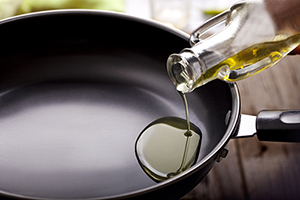We’ve long been propagandized about the imperative to switch from saturated fat to plant-derived oils. I’ve pushed back on that shaky proposition in an article entitled “The Weak Case Against Saturated Fats”.
But just as the old shibboleth about animal fat is being debunked, a new dogma is emerging: That vegetable oils are the most pernicious feature of Western diets, and that they are chiefly responsible for the wave of degenerative diseases that afflict industrialized countries—and, therefore, they should be expunged from our diets.
Hyperbolic headlines like these abound:
“Dr. Mark Hyman: Why Vegetable Oils Should Not Be Part of Your Diet”
“The Ugly Truth About Vegetable Oils (and why they should be avoided)”
There are so many of these articles and social media posts, that it’s become kind of a cliché—a litmus test of nutritional virtue.
On the other hand, posts like this are now appearing: “Scientists debunk claims of seed oil health risks”
Harvard researchers report: “While the internet may be full of posts stating that seed oils such as canola and soy are ‘toxic,’ scientific evidence does not support these claims.”
I’m an equal-opportunity debunker, so, in the spirit of Intelligent Medicine, I decided to take a closer look at this controversy. And what I found doesn’t hew as closely to the “party line” of many diet gurus.
Admittedly, there’s a strong rationale for questioning the nutritional desirability of all those seed oils:
- They’re “unnatural”: The godfather of the Paleo Diet, Dr. Loren Cordain, points out:“Vegetable oils were obviously not a component of any pre-agricultural or hunter-gatherer diet, simply because the technology to produce them did not exist. Oils made from walnuts, almonds, olives, sesame seeds, and flax seeds were first produced using crude presses between 5,000 and 6,000 years ago. However, except for olive oil, most early use of oils was for non-food purposes such as illumination, lubrication, and medicine. It wasn’t until the beginning of the 20th century with the advent of mechanically driven steel expellers and hexane extraction processes did vegetable oils contribute significantly to the energy intake of the western diet.”
- They upset the Omega-3:6 Ratio: Most vegetable oils are predominantly Omega-6, which is said to be pro-inflammatory, prothrombotic and proatherosclerotic, as opposed to Omega-3, which has opposite effects. Cordain writes:“Today, vegetable oils used in cooking, salad oils, margarine, shortening, and processed foods supply 17.6% of the total daily energy intake in the U.S. diet. The enormous infusion of vegetable oils into the western diet starting in the early 1900s represents the greatest single factor responsible for elevating the dietary omega-6-to-omega-3 ratio to its current and unhealthful value of 10. In hunter-gatherer diets, the omega-6/omega-3 ratio was closer to 2.”
- They are highly-processed: The high temperature and chemical extraction methods used to produce these oils runs the risk of damaging them, converting a proportion of them into harmful trans fats, and leaving chemical residues like hexane.
- They are vulnerable to heat damage: When cooking at high temperatures, their unsaturated chemical bonds are rendered even more susceptible to oxidation, or increased transformation to unhealthy trans fats; moreover, beneficial contents like vitamin E and polyphenols may be degraded at high temperatures.
- They adversely affect lipids: While studies show consumption of the Omega-6 linoleic acid lowers cholesterol, a recent review (“Omega-6 vegetable oils as a driver of coronary heart disease: the oxidized linoleic acid hypothesis”) argues that a preponderance of dietary Omega-6s “increases susceptibility of LDL and other lipoproteins to oxidation; increases small-dense LDL; reduces HDL; and increases triglycerides”. All are thought to be drivers of cardiovascular risk.
- They can make you fat: A study of middle-aged women found that higher red blood cell levels of Omega-6 fatty acids were associated with overweight; higher levels of Omega-3 were found in leaner individuals.
So what does the latest science say?
Since linoleic acid (LA) is the most abundant Omega-6 in seed oils, we might expect that higher blood levels of LA would be associated with cardiovascular risk. (We already know that higher levels of the Omega-3s, EPA and DHA, are protective). But that’s not what was found in a 2014 study (“Circulating omega-6 polyunsaturated fatty acids and total and cause-specific mortality: the Cardiovascular Health Study”); in fact, higher levels of LA were found to be associated with lower risk of cardiac events and death from any cause:
“There was little evidence of associations of n-6 PUFA with total mortality . . . Evaluating both n-6 and n-3 PUFA, lowest risk was evident with highest levels of both.”
A Cochrane Review in 2015 found “insufficient evidence to show an effect of increased or decreased omega 6 intake on CVD risk factors such as blood lipids and blood pressure.”
I think it’s going to be difficult to sort out these seemingly irreconcilable positions. On the one hand, Since Omega-6 fatty acids are ubiquitous in ultra-processed foods, it might just be that its prevalence in diet records or in blood samples is simply a marker for people who eat more junk, thus incriminating it in some studies as the culprit, when it’s really just a matter of subjects’ overall bad diets.
Also, it’s undeniable that there are some health benefits to a plant-based diet, which is of necessity skewed toward Omega-6s; healthy vegetarians who aren’t eating lots of fried or processed foods, but who consume lots of heart-healthy nuts and seeds, rich in linoleic acid, don’t seem to be harmed by their disproportionate intake of Omega-6s.
Popular podcaster Dr. Andrew Huberman, to whom I often listen, offered his take on seed oils on his first AMA episode on 11/2/2022. as summarized in a post on Seed Oil Scout, an app designed to enable “the community of conscious diners to map out restaurants that care for their customers by cooking with healthy oils.”
Dr. Huberman concludes there is scanty evidence in major peer-reviewed clinical trials that seed oils, per se, are as harmful as many people are claiming them to be; however he does acknowledge their excess consumption may be contributing to health problems. They are ubiquitous, cheap, and calorically dense.
“In the last two decades and in particular in the last 10 years the consumption of seed oils has gone up dramatically, that is true, and that the caloric content of seed oils may in some ways, perhaps in many ways [may] be contributing to the so called ‘obesity epidemic’”
I think that a prohibition of Omega-6s is a bridge too far. I’ll leave you with some ways to minimize their harms, while consuming a diverse diet:
- Whenever possible, use organic cold-pressed oils. They are less likely to be structurally damaged by harsh processing or heat, or rendered toxic with hexane or herbicide residues.
- Avoid deep-frying, especially at fast-food restaurants. The oils get re-used, and with each cycle of food production, oxidized byproducts and trans-fats build up.
- Avoid heating oils past their smoke point. Many vegetable oils, especially olive oil, can stand up to cooking, but are adversely altered when heated too high.
- For sautéing, try alternating from time to time with more stable heat-tolerant saturated fats like ghee or coconut oil, or even lard or duck fat, to reduce cumulative exposure to Omega-6s.
- Minimize consumption of prepared food products loaded with sketchy Omega-6s like commercial salad dressings, condiments, French fries, fish sticks, chicken fingers, cookies, candies and cakes; on the other hand, no need to eschew nuts, seeds, and legumes, which, while rich in Omega-6s, may deliver healthy prebiotic fiber, phytosterols, vitamins and minerals, and polyphenols.
- Eat grass-fed or pastured dairy products, eggs, poultry and meat. You are what what you eat eats; grain-based animal feeds are replete with Omega-6s, impacting the fat composition of products from conventional livestock. Even wild-caught fish deliver a better Omega-6:3 ratio than farmed fish.
- Make sure you include fatty fish and/or Omega-3 supplements in your diet to offset imbalances in your Omega-3:6 ratio.







